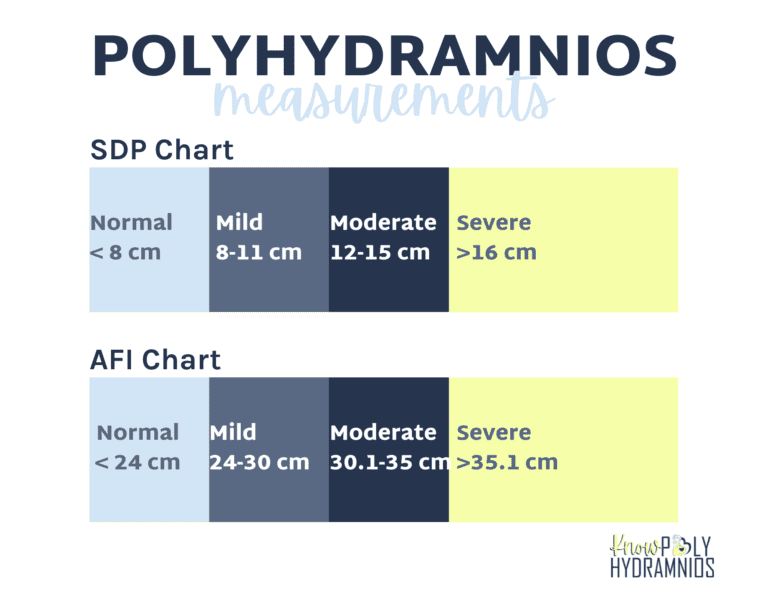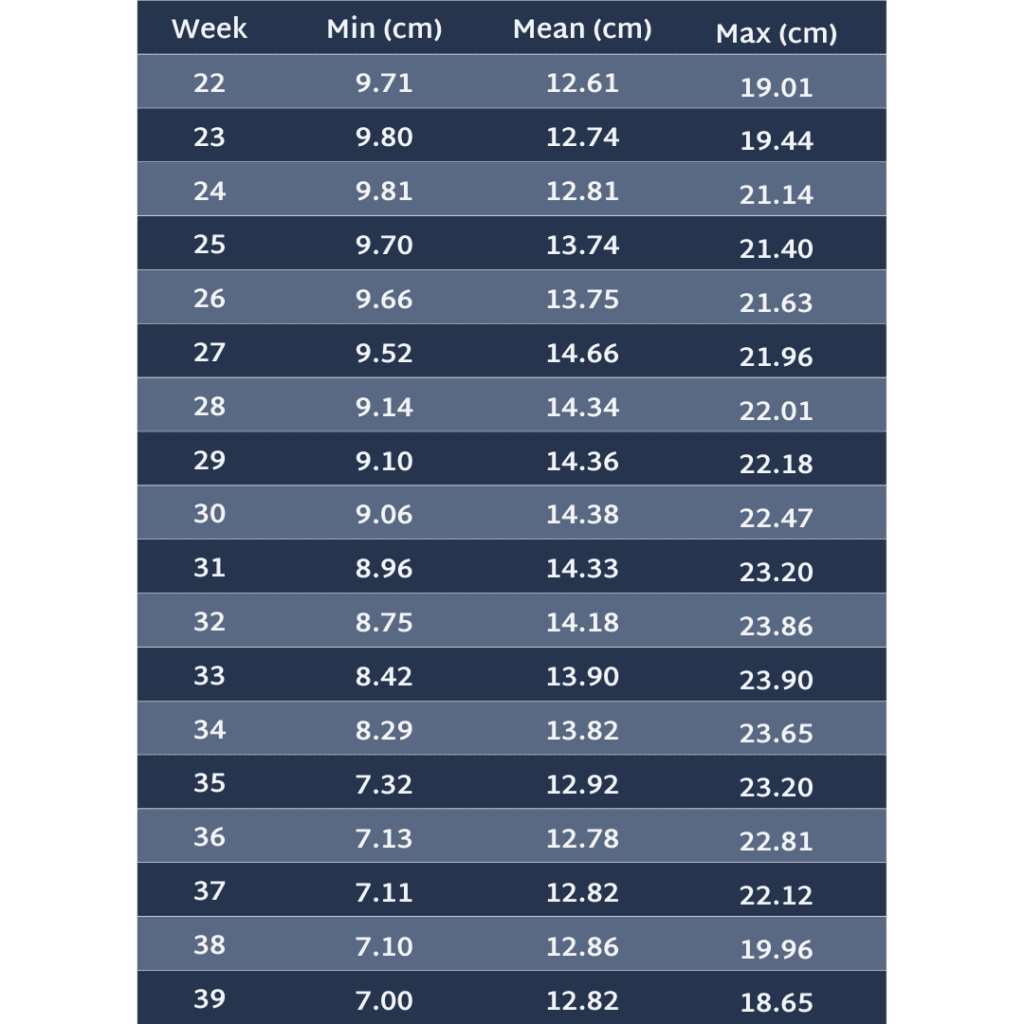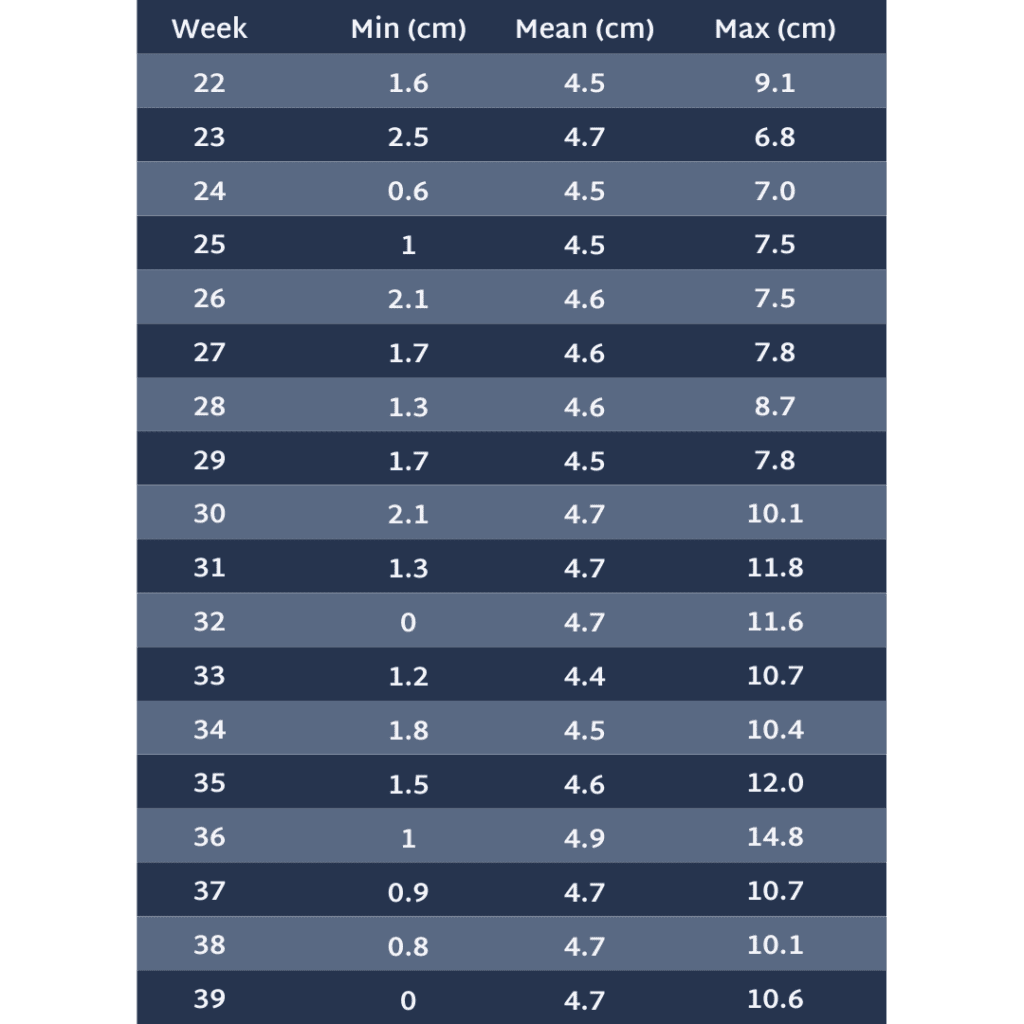Amniotic Fluid Index
Amniotic Fluid Index, AFI, is the sum total measurement, in centimeters, of the deepest pocket of amniotic fluid in each of the four quadrants of the uterus. SDP stands for Single Deepest Pocket and it is the measurement, in centimeters, of the deepest pocket in just one quadrant. SDP is also referred to by other names such as deepest vertical pocket (DVP), deepest pool, maximum vertical pocket (MVP), etc.
The level of amniotic fluid varies by gestational age and from woman to woman, but it is widely accepted that an AFI between 5 cm and 24 cm, or an SDP below 8 cm, is considered normal. An AFI above 24 cm or an SDP above 8cm is typically labeled as Polyhydramnios.
Table of Contents
Symptoms
How is Amniotic Fluid Measured?
During an ultrasound, the sonographer will divide the belly into four sections, or quadrants. (Imagine a line being drawn down the middle of the belly from top to bottom, and another one running side to side that passes through the belly button.) Holding the transducer in one quadrant staying at a right angle to the sagittal plane of the abdomen, the sonographer will then find the deepest area of free space. This space should be completely free from baby parts and the umbilical cord. Once the deepest space is found, a measurement is taken in centimeters.
The process is repeated in each of the other three quadrants. At the end of the ultrasound, there are four pocket measurements. The largerst one is what is referred to as the Single Deepest Pocket, or SDP. To calculate the total Amniotic Fluid Index, or AFI, the four measurements are added together.
Amniotic Fluid should be measured in centimeters but occasionally some clinics use millimeters. This is an easy conversion by simply dividing by 10. For example, an SDP reading of 100 millimeters is equal to 10 centimeters (100/10=10), or an AFI reading of 385 millimeters is equal to 38.5 centimeters (385/10=38.5).
What do Amniotic Fluid Measurements Mean?
Amniotic fluid is measured during pregnancy because both too little (oligohydramnios) and too much (polyhydramnios) fluid are linked to poor outcomes. Studies have shown a direct correlation between increasing levels of amniotic fluid and adverse outcomes. (Example) There is also evidence to support that higher levels of amniotic fluid may also be linked to higher rates of aneuploidy and other genetic anomalies in babies.
Amniotic fluid measurements are broken into three categories:
Mild
AFI → 24 – 30 cm
SDP → 8 – 11 cm
Moderate
AFI → 30.1 – 35 cm
SDP → 12 – 15 cm
Severe
AFI → 35.1+ cm
SDP → 16+ cm
*New evidence has shown that patients who had one SDP greater than 8 cm, but a total AFI of less than 24 cm experienced a much lower rate of adverse outcomes. This evidence suggests that AFI is a more reliable measurement for diagnosing the presence of Polyhydramnios. In addition, NHS Royal Cornwall Hospitals have suggested only using SDP until a measurement >8 cm exists, then using AFI to further evaluate for the existence of Polyhydramnios.

How Accurate is AFI?
Amniotic fluid measurements are very subjective. Many factors influence the measurement including how the baby is lying, whether the baby has just peed or not, the technician performing the measurements, the technique used to measure, the position of the transducer, the mother’s unique body shape, and how she carries.
A one-time measurement is not as important, or as telling, as the trend of the measurements over time. Keeping track of amniotic fluid measurements can help a woman and her medical team come up with the best care plan.
What is a Normal Amniotic Fluid Level?
Amniotic fluid naturally increases as pregnancy progresses and tends to peak between 29-34 weeks. After that, levels decline as the fluid begins to be absorbed by maternal and fetal tissues. Then it takes a dramatic decline again around 36 weeks.
Average AFI and SDP Ranges


Average AFI and SDP Ranges
We created AFI and SDP tracking charts for pregnant women to keep track of their amniotic fluid levels.
FAQs
FAQs
In some cases, amniotic fluid may be reduced by managing the underlying condition. For example, a diabetic diet may help reduce fluid in women with high blood sugar levels. Amnioreduction and indomethacin have also been used to reduce amniotic fluid, although these methods are only recommended under extreme circumstances. Some women have also reported a reduction in amniotic fluid after using the herb Nat Mur, however, we recommend you research this product and speak to your healthcare provider before trying it for yourself. Read more on the management of Polyhydramnios here.
If your AFI is greater than or equal to 24 cm, you will be screened for underlying conditions such as diabetes, infection, or Rh incompatibility. Your baby will also be checked via ultrasound for obvious fetal anomalies. You and your baby will be monitored closely for the duration of your pregnancy and during labor and delivery. It’s important to note that as AFI increases, so do the risks of perinatal mortality and congenital abnormalities. Learn about the proper testing you need after a Polyhydramnios diagnosis here.
Read Next
Signs of Polyhydramnios – A larger than expected uterus, difficulty breathing, excessive swelling, and other exaggerated late-term pregnancy symptoms are all signs of polyhydramnios.
